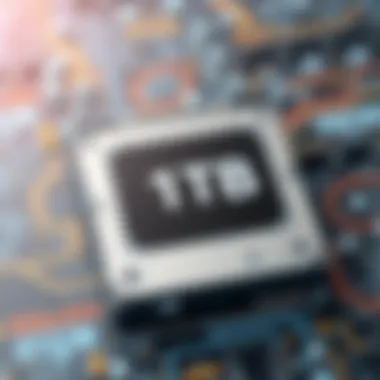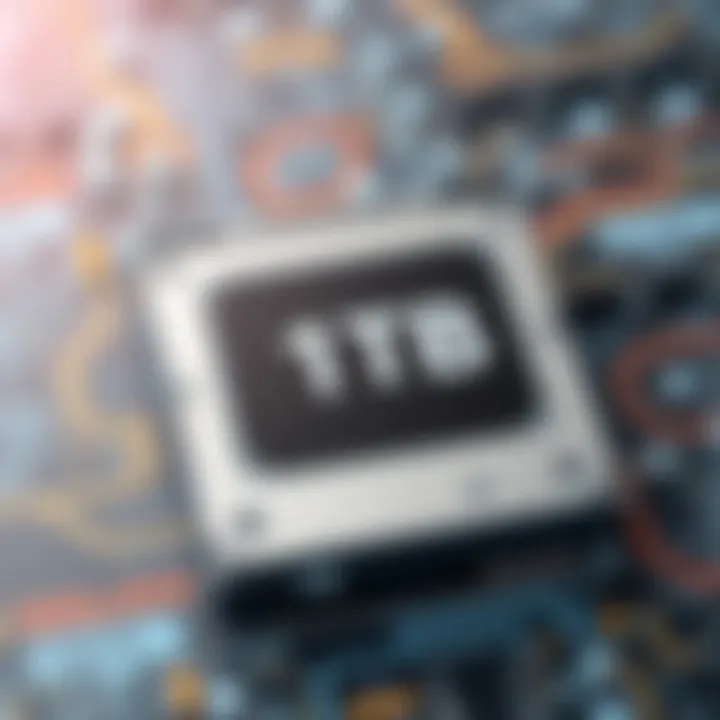In-Depth Review of 1TB SATA Solid State Drives


Intro
In today’s world, where data reigns supreme, understanding storage technology is not just a technical hobby; it’s a necessity. The 1TB SATA Solid State Drive (SSD) is a prime example of how far we’ve come in terms of data storage. This article provides an in-depth look at SATA SSDs, aiming to equip both IT professionals and enthusiasts with detailed insights into their functionalities, advantages, and the latest trends.
So, what’s the deal with these SSDs, and why are they a hot topic? To put it plainly, a SATA SSD offers enhanced performance and speed over traditional hard drives, making it an appealing choice for a variety of applications—from gaming to server management. The relevance stretches beyond mere numbers; the implications for efficiency and capacity can shape entire infrastructures.
Understanding Storage, Security, or Networking Concepts
Introduction to Storage
Storage technology has advanced at such a pace that understanding its core concepts is crucial. Got files? Ideally, you want a fast and reliable way to access them. This is where SATA SSDs come into play. They utilize the same interface as traditional hard drives, but work differently under the hood. Unlike mechanical drives, SSDs lack moving parts, which not only improves speed but also durability.
Key Terminology and Definitions
When diving into the world of SSDs, you’ll come across terms like read/write speeds, latency, and IOPS (Input/Output Operations Per Second). Understanding these terms can be as key as getting the right hardware. For example, the IOPS metric gives insight into how many operations an SSD can handle in a second, reflecting its performance capabilities.
Overview of Important Concepts and Technologies
Technologies like TRIM and SLC (Single Level Cell) play essential roles in maintaining SSD performance over time. TRIM enables the operating system to inform the SSD about unused data blocks, helping to optimize performance. SLC, on the other hand, is the fastest type of NAND storage but brings higher costs.
Now that we’ve set the stage, let’s shift gears to explore the practicalities of optimizing these storage solutions.
Understanding SATA Technology
In the realm of computer storage, the SATA (Serial Advanced Technology Attachment) interface stands as a pivotal technology driving the operation and efficiency of Solid State Drives. As computers and devices evolve, the underlying storage infrastructure must keep pace, providing both speed and reliability. Understanding SATA technology is essential for anyone looking to comprehend the nuances of modern data storage solutions, particularly in the context of 1TB SATA SSDs. This section will delve into the core aspects of SATA, its advantages, and what professionals should consider when evaluating systems that employ this interface.
What is SATA?
SATA, short for Serial Advanced Technology Attachment, is an interface that connects storage devices like SSDs and hard drives to a motherboard. It replaced the older Parallel ATA (PATA) interface, primarily due to its ability to support faster data transfer rates and more efficient communication between the components. Within a SATA system, data flows in a serial manner, allowing for faster connection speeds that can reach up to 6 Gb/s in SATA III, which is the current prevalent standard.
SATA technology has become synonymous with personal computers, servers, and a variety of electronics. One notable feature is its hot-swappable capability, allowing users to add or remove drives while the system is operational. This characteristic is crucial for maintaining uptime in servers and for users who require flexible storage solutions.
Advantages of SATA Interface
The adoption of SATA technology has introduced several advantages that cater to various needs in both consumer and professional environments. Some of these benefits include:
- Speed: SATA III offers impressive transfer rates, up to 6 Gb/s, enabling fast read and write operations crucial for performance.
- Compatibility: A vast array of devices support SATA technology, making it easier to integrate into existing systems without compatibility issues.
- Cost-Effectiveness: SATA SSDs tend to be more affordable compared to their NVMe counterparts, thus appealing to budget-conscious users while still delivering substantial performance improvements over traditional HDDs.
- Power Efficiency: SATA drives consume less power compared to their PATA predecessors, which helps in reducing overall energy usage, a key factor for users mindful of their environmental footprint.
These elements together create an ecosystem where SATA SSDs have carved a niche, especially for average consumers and businesses seeking a balance between cost and performance.
"SATA drives are an unsung hero in the storage landscape, offering a remarkable combination of speed and affordability that meets the diverse needs of users from all walks of life."
Exploring Solid State Drives
The realm of data storage has taken a major turn over the last decade, with Solid State Drives (SSDs) stepping into the spotlight. Unlike traditional spinning hard drives, SSDs have no moving parts, leading to a plethora of advantages ranging from speed to durability. This section aims to unpack the importance of exploring SSDs in the context of a 1TB SATA drive. Understanding the intricacies of SSD technology is paramount for anyone looking to enhance their computer’s performance or dive into data-intensive tasks.
Why SSDs Matter
In today's fast-paced digital environment, time is money, and SSDs deliver just that by significantly reducing boot times and application launch speeds. As tasks require more data processing—especially for gamers, creative professionals, and businesses—SSDs have become essential components in modern hardware setups. Their ability to handle high workloads while maintaining reliability is crucial.
Definition and Functionality
An SSD, or Solid State Drive, is a data storage device that utilizes flash memory to store data, making it faster than traditional hard drives. SSDs are built with integrated circuits that allow for quicker data access and retrieval. Essentially, when you save or access a file, SSDs enable this to happen in a fraction of the time it would take a hard drive.
The absence of mechanical components is a game changer. Since they don’t have moving parts, SSDs are also more resistant to physical shock, leading to a longer lifespan. This reliability also means they can handle more read and write cycles, making them ideal for heavy workloads.
Types of SSDs
Understanding the different types of SSDs is key to making informed decisions about storage solutions. Not all SSDs are created equal, and certain types, like SATA and NVMe, cater to different needs.
SATA SSD
SATA SSDs use the Serial ATA interface that has been around for a while. A primary advantage of SATA SSDs is their compatibility with older computers that might not support newer interfaces, making them a practical choice for users upgrading from HDDs. They are known for a solid balance between price and performance.
Key Characteristics
- Cost-Effective: Generally more affordable compared to NVMe counterparts.
- Widespread Adoption: Perfect for casual users and those looking to enhance basic machines without breaking the bank.
One unique feature of SATA SSDs is the Sustained Write Performance. They achieve decent read speeds—typically around 550 MB/s—but it's the write speeds that can lag. This makes SATA SSDs suitable for everyday tasks, but not optimal for demanding applications or environments where high write speeds are necessary.
NVMe SSD
NVMe, or Non-Volatile Memory Express, represents a leap in storage technology, utilizing the PCIe interface to deliver much higher speeds than SATA. Users looking for top-tier performance often gravitate towards NVMe SSDs for their remarkable abilities.


Key Characteristics
- Ultra-Fast Data Transfer: Some NVMe SSDs can reach speeds over 3,500 MB/s.
- Reduced Latency: Accelerated response times make these drives feel instantaneous.
However, the disadvantage lies in their price point; NVMe SSDs can be more expensive than SATA SSDs. They are ideal for gamers, professionals dealing with large file sizes, or anyone focused on speed and efficiency.
In-Depth Analysis of 1TB SSDs
The exploration of 1TB SATA Solid State Drives offers a fascinating perspective on how this technology shapes our digital experience. Understanding capacity and performance metrics is crucial for making informed decisions, whether you are a tech enthusiast or a professional in the field. With the growing reliance on high-speed storage for both personal and business applications, this section delves deeply into aspects that define the functionality and longevity of SATA SSDs. Evaluating elements like read/write speeds and endurance not only aids in grasping practical benefits but also highlights considerations that are critical before making a purchase.
Capacity and Performance Metrics
Read/Write Speeds
Read and write speeds serve as the lifeblood of any storage device, particularly SSDs. The faster these speeds, the quicker data can be transferred to and from the storage medium. For a 1TB SATA SSD, typical read speeds hover around 500-550 MB/s, while write speeds can range slightly lower. This is where SATA SSDs show their versatility; they often provide sufficient speed for daily tasks, media consumption, and even moderate gaming.
However, what makes SATA SSDs a popular choice is their balance in performance versus cost. Many users find them beneficial for boot drives, as quick access to the operating system simplifies daily tasks and overall responsiveness. One unique feature of read/write speeds is their consistency across different workloads, which helps avoid performance dips during intensive tasks, unlike traditional HDDs that can lag or stutter.
Quick Note: The read/write speeds can drastically affect load times, making them a fundamental consideration for anyone looking to optimize their system's performance.
IOPS
Input/Output Operations Per Second (IOPS) is another crucial performance metric, particularly in environments that demand high transaction rates, such as servers or databases. SATA SSDs often achieve IOPS ranging from 75,000 to 100,000, which is a significant improvement over traditional spinning hard drives. This measurement primarily reflects the drive's capability to handle concurrent requests, which is vital in multi-user environments where speed and efficiency are paramount.
The uniqueness of IOPS lies in its ability to affect user experience directly. When applications require rapid access to data, higher IOPS translates to smoother performance and better multitasking. Although SATA drives may not reach the extreme IOPS figures of NVMe SSDs, they provide enough firepower for general consumer applications and even moderate enterprise uses.
Endurance and Reliability
Endurance and reliability are two sides of the same coin and are key factors in assessing the overall value of a 1TB SATA SSD. Each SSD has a limited number of program/erase cycles, often measured in terabytes written (TBW). A typical 1TB SATA SSD can handle around 300 to 600 TB of data written over its lifespan.
A common misconception is that all SSDs are susceptible to failure after a certain period. However, modern SATA SSDs come equipped with wear-leveling algorithms and error-correcting code, contributing towards a much longer lifespan. Furthermore, advertising durability ratings can help users gauge which drives meet their needs without excessive wear.
SATA vs. Other Storage Solutions
When delving into storage technology, understanding the differences between SATA SSDs and other storage solutions is critical. Given the multitude of choices available today, each option possesses distinct features, benefits, and drawbacks that may sway the decision-making process for both casual users and industry professionals. This section aims to provide a clear, nuanced comparison among these storage solutions.
Comparing SATA SSDs and HDDs
To start off, let's take a closer look at the rivalry between SATA solid state drives (SSDs) and traditional hard disk drives (HDDs). It’s like comparing apples and oranges—both serve the same purpose but do so in entirely different manners.
SATA SSDs are often lauded for their speed and reliability. They achieve this due to the lack of moving parts, which also means there’s less risk of mechanical failure. Users often notice this speed advantage in tasks such as booting up the operating system or loading applications, where SATA SSDs shine brightly. In fact, these drives can typically deliver read speeds exceeding 500MB/s, compared to HDDs that often drag along at around 80-160MB/s. This speed can be a game changer for gamers or those handling large files, resulting in a more fluid experience overall.
However, HDDs still hold their ground, primarily due to their cost-effectiveness when it comes to storage capacity. For users looking for bulk storage without breaking the bank, HDDs can offer several terabytes for a fraction of the cost of similar-capacity SSDs. The slowest HDD struggles to match the pace of even the most basic SATA SSD, but if you're simply storing pictures and videos, that difference may not be as impactful.
Key Differences:
- Speed: SATA SSDs significantly outperform HDDs in read and write times.
- Mechanical Components: SATA SSDs have no moving parts, enhancing durability and performance.
- Cost per GB: HDDs generally provide a better cost per gigabyte for high-capacity needs.
So, when weighing your options, it’s essential to evaluate your specific needs. If performance is a top priority, a SATA SSD is the way to go. Yet, for those who prioritize storage space without the high price tag, HDDs can still prove beneficial.
SATA vs. NVMe Performance
Shifting gears to talk about NVMe, or Non-Volatile Memory Express, also brings another layer of complexity to the equation. While SATA has been the classic choice for SSDs, NVMe is breaking new ground, making the conversation about storage quite intriguing. The performance differences here are stark and worth discussing in detail.
NVMe technology is designed specifically for SSDs, optimizing the way data is transferred between the SSD and the computer. Thus, SATA drives, while fast, are limited by the older SATA interface. These limitations can significantly impact performance during high-demand scenarios, such as gaming or video editing where rapid data transfer is critical.
In real-world terms, NVMe drives can showcase read/write speeds that can reach beyond 3000MB/s, rendering them exceptionally suited for tasks requiring quick data retrieval. For instance, if a media producer is working with 4K video files, the difference in data handling from NVMe to SATA could mean the difference between a smooth workflow and an experience riddled with lag.
Summary of Performance Metrics:
- Data Transfer Speeds: NVMe drives can surpass 3000MB/s compared to SATA’s maximum of around 600MB/s.
- Latency: NVMe provides lower latency, meaning quicker response times in communication with the CPU.
- Parallelism: NVMe can handle multiple data streams better due to its architecture, improving overall efficiency.
To sum up, if your workloads involve heavy data transfers and you crave speed, investing in NVMe is wise. On the other hand, SATA SSDs remain a solid, cost-effective choice for those looking for enhanced speed over traditional HDDs without the top-tier performance that NVMe offers.
Ultimately, the right choice boils down to your personal requirements, budget, and how you intend to use your storage solution. Making an informed decision between these technologies is vital for achieving optimum performance.
Applications of 1TB SATA SSDs


The versatility of 1TB SATA SSDs makes them invaluable tools in modern technology. As we explore their applications, it becomes evident that their integration into various sectors enhances both performance and user experience. Understanding where and how these drives are utilized sheds light on their importance in meeting the demands of today’s digital landscape.
Usage in Consumer Electronics
In the realm of consumer electronics, 1TB SATA SSDs have become increasingly popular choices due to their balance of capacity and cost. These drives have found a home in laptops, desktops, and gaming consoles, providing users with a seamless experience.
One primary benefit of utilizing SATA SSDs in consumer devices is the speed boost they offer compared to traditional hard disk drives (HDDs).
- Faster Boot Times: Users notice significantly reduced boot times. Where an HDD might take a minute to start up, SSDs can often cut that down to mere seconds.
- Enhanced Application Launch: Programs load almost instantaneously, which is especially beneficial for gamers who require quick access to data.
- Energy Efficiency: SSDs consume less power, which is a vital consideration for battery-powered devices such as laptops. This results in longer battery life for portable devices.
The 1TB capacity also allows consumers to store large files, be it extensive gaming libraries, high-resolution videos, or large applications, without worrying about running out of space. Considering that many users seek to have a diverse collection of media and tools, the demand for reliable and spacious drives continues to grow.
Integration in Data Centers
In the context of data centers, 1TB SATA SSDs serve a foundational role, acting as critical components for data management and processing. With the growing trend of cloud computing and data storage, the importance of these solid-state drives cannot be overstated.
Data centers benefit from:
- Improved Performance: The reduced latency associated with SATA SSDs allows for faster read and write operations. This is essential as data centers handle vast amounts of data and require efficient processing to meet customer demands.
- Reliability: SSDs are less prone to mechanical failure than traditional hard drives. This reliability is crucial in a data center environment where uptime is key. A failure can lead to significant financial loss, making the durability of these drives essential.
- Scalability: As data needs increase, scaling storage solutions becomes easier with SATA SSDs. Their compact design means data centers can store more drives within a smaller physical footprint, enabling flexibility in infrastructure.
Furthermore, deploying these drives in cloud services facilitates swift data access for enterprises, helping them to serve clients efficiently.
"The integration of 1TB SATA SSDs into both consumer electronics and data centers reflects a larger trend towards prioritizing performance and efficiency in technology, paving the way for innovations that better serve user needs."
Key Manufacturers of SATA Solid State Drives
When considering SATA Solid State Drives, recognizing the main manufacturers in the market is crucial. This selection influences purchasing decisions, which can significantly affect performance and reliability. The key players not only provide various models to meet user needs but also contribute to advancements in technology and drive innovation in the industry. By examining these manufacturers, one can gain insights into what defines quality and longevity in storage solutions.
Major Players in the Market
Samsung
Samsung has established itself as a titan in the SSD market. Known for their quality products, Samsung's 1TB SATA SSDs, like the Samsung 870 EVO, are often touted for their remarkable performance and endurance. The standout feature of this drive is its V-NAND technology, which enhances speed and efficiency. Users appreciate the reliability that comes with Samsung products, which is why they are often a go-to option for both consumers and professionals.
One significant advantage of Samsung’s offerings is data security. Their SSDs often come with built-in AES 256-bit hardware encryption, making them suitable for various applications requiring enhanced security measures. However, the price point can be a disadvantage for budget-conscious consumers, as premium features tend to demand a higher cost.
Western Digital
Western Digital, often recognized for its extensive range of storage options, brings solid reliability to the table with products like the WD Blue SATA SSD. Prominent for its affordability, Western Digital offers great value without skimping on essential performance metrics. The Blue series is especially liked by casual users aiming to upgrade from HDDs without breaking the bank.
A unique aspect of Western Digital is its use of 3D NAND technology, which improves durability and capacity. However, while the drives perform admirably in everyday tasks, power users may find them lacking compared to higher-end brands. Western Digital proves to be a practical choice for many everyday users and students who don’t require the absolute best performance.
Crucial
Crucial, a division of Micron Technology, has carved a niche with its Crucial MX500 line of SATA SSDs. Known for offering a good balance between price and performance, these drives are a fantastic option for users looking to enhance their storage without spending a fortune. The integrated power loss immunity feature in these models is a remarkable selling point. It helps protect data in case of unexpected power interruptions, which provides peace of mind.
The MX500 also boasts fast read and write speeds, making it an appealing choice for gamers and content creators alike. The downside? While its performance is commendable for most applications, heavy-duty professionals might find it insufficient when handling more intensive tasks. Crucial remains a popular brand for those seeking a mid-range option that performs well across general usage scenarios.
Emerging Brands
While established names dominate the market, several emerging brands are making waves in SSD technology. These players are often nimble, addressing niches and innovating where bigger companies may lag. By focusing on exceptional performance, unique features, or competitive pricing, these brands present interesting alternatives.
In summary, choosing a SATA SSD hinges on understanding what these manufacturers bring to the table. Each brand presents its own unique features, performance metrics, and pricing strategies that cater to different consumer needs. By diving deeper into what these manufacturers are about, one can make informed decisions when selecting among the myriad of storage solutions available today.
Future Trends in SATA SSD Technology
The landscape of storage technology is ever-evolving, and SATA solid-state drives are no exception. As we venture further into the digital age, understanding future trends in SATA SSD technology becomes crucial, particularly for IT professionals and cybersecurity experts. Staying informed about these developments can illuminate the trajectory of storage solutions and assist in making educated decisions when selecting a storage device for varied applications.
Advancements in Storage Capacities
SATA SSDs have significantly progressed over the years regarding storage capacities. Initially, small-scale capacities defined the landscape, with drives often maxing out at 120 GB or 240 GB. Nowadays, thanks to advancements in NAND flash technologies and manufacturing processes, we see 1TB and larger drives becoming commonplace. This gradual increase caters to the burgeoning demands of data-centric applications across various sectors.
- 3D NAND Technology: By stacking memory chips vertically, manufacturers have optimized storage efficiency and performance. This technology not only boosts the capacity but also enhances durability. It enables users to store more data without compromising speed or reliability, which is particularly beneficial for big data applications.
- Future Capacity Projections: Analysts predict that we'll witness capacities exceeding 4TB and beyond in the coming years. This leap forward will likely accommodate the growing computational needs of cloud computing and enterprise-level storage solutions, enabling organizations to manage vast amounts of data seamlessly.
As data storage needs grow, advancements in storage capacities will be paramount in providing the necessary resources for data-driven industries.
Understanding these trends allows organizations and individuals to be proactive, ensuring they invest in the right technology to meet their current and future needs.


The Evolution of Interface Standards
Interface standards are another critical area of evolution in SATA SSD technology. While SATA III has been the dominant interface, higher-speed alternatives like NVMe have surfaced, carving out space for themselves in the storage market. However, SATA technology is evolving, primarily to complement these advancements.
- SATA Express: This dual interface merges SATA's practicality with PCIe speed capabilities, allowing SATA drives to communicate more efficiently with the motherboard. Though it hasn’t gained massive traction yet, it demonstrates a willingness in the industry to innovate.
- Ongoing Improvements: As manufacturers optimize SATA protocol and queue depth capabilities, we can expect future SATA interfaces to provide more efficient data transfer rates and better performance in environments requiring fast read and write speeds. Enhanced features such as error correction and improved power management are also anticipated.
The evolution of interface standards not only shapes how we interact with SSDs but also determines their integration across a wide array of platforms. Future developments will likely lead to a wider compatibility spectrum, enabling seamless use across different devices and operating systems.
Staying abreast of these trends ensures that users remain competitive in an increasingly data-driven world, maximizing both performance and value from their SATA solid-state drives.
Considerations for Choosing a SATA Solid State Drive
When it comes to selecting a SATA Solid State Drive, particularly one with a capacity of 1TB, several factors come into play that can significantly influence both performance and user experience. Understanding these considerations is vital for IT professionals, cybersecurity experts, and students alike, allowing them to make informed decisions that align with their specific needs and budget constraints.
Assessing Performance Needs
Performance is often the linchpin when choosing a solid state drive. Buyers must first identify their specific requirements. For example, if you're a gamer, you might be looking for rapid load times and high IOPS (Input/Output Operations Per Second) for a seamless performance during gameplay. Alternatively, if you're working on large datasets or running virtual machines, sequential read and write speeds are paramount.
When evaluating performance metrics, consider the following:
- Read/Write Speed: This is a crucial factor, especially for tasks requiring fast data retrieval. Look at both sequential and random speeds. Sequential speeds can particularly affect transfer times when moving large files.
- IOPS: A high IOPS means the SSD can handle more operations per second. This is especially important for applications with heavy multitasking or that require quick access to small files.
- Endurance Rating: Some SATA SSDs come with a specific endurance rating, measured in TBW (Terabytes Written). This rating indicates how much data can be written over the drive’s lifetime, thus providing insights into its longevity.
By aligning these performance factors with your tasks, you can select an SSD that meets or exceeds your expectations.
Budgetary Constraints
While performance is a major consideration, budget constraints can greatly affect your choice of a SATA SSD. The market offers a range of options, from entry-level drives to more premium models. Here are a few aspects to keep in mind when budgeting for your purchase:
- Cost per Gigabyte: Compare costs across brands and models. Sometimes, a slightly pricier drive may offer significantly better performance or durability, making it a more prudent long-term investment.
- Compromise on Features: If you’re not using the drive for intensive tasks, consider whether you need the highest specs. For general use, a more economical model might suffice, saving you money.
- Warranty and Support: A better warranty can save costs in the long run. Some manufacturers offer extensive warranties, making their drives a safer investment, even if the upfront cost is higher.
When navigating budget limitations, it’s beneficial to prioritize your needs. However, skimping on essential features just to save a few dollars might lead to dissatisfaction in the long run.
In summary, the key to choosing the right SATA SSD lies in assessing your performance requirements while also keeping a close eye on your budget. Balancing these elements ensures that you select a storage solution that not only fits your immediate needs but also offers durability and reliability for future demands.
Installing and Maintaining SATA SSDs
When it comes to maximizing the lifespan and performance of your SATA Solid State Drive, a keen understanding of installation and maintenance practices is not merely advantageous; it's essential. Proper handling during both set-up and ongoing upkeep can significantly influence the reliability and efficiency of your storage. Whether you're a seasoned IT professional or a student navigating your way through tech, knowing the ins and outs of SATA SSD care is invaluable.
Installation Process Overview
The installation of a SATA SSD might seem straightforward, but it's a process where precision meets caution. Here’s a step-by-step guide to ensure everything runs smoothly:
- Selecting the Right Drive: Start by ensuring that the SATA SSD suits your system's specifications, like interface compatibility and size.
- Gather Tools: You will need a Phillips screwdriver, anti-static wrist strap, and possibly a SATA cable if your system doesn’t have one pre-installed.
- Power Down: Always turn off your computer and unplug it before beginning the installation to avoid any electrical mishaps.
- Open the Case: Carefully remove the side panel of your computer case, ensuring not to touch any sensitive components without proper anti-static precautions.
- Locate Drive Bays: Identify the appropriate bay for your SSD, as some systems have dedicated slots for SSDs.
- Mount the SSD: If required, secure the SSD using screws to ensure stability. Connect the SATA cable from the SSD to the motherboard, and attach the power cable from the power supply.
- Closing Up: Replace the side panel of your case, plug the system back in, and power it on.
- Drive Initialization: Go into the operating system’s disk management tool to format the SSD and assign it a drive letter.
Following these steps can help prevent common pitfalls—ensuring that your SSD is recognized and operates at optimal capacity.
Regular Maintenance Practices
Once your SATA SSD is up and running, maintaining its health becomes the next priority. Regular checks and practices can significantly reduce the risk of potential failures. Here are a few upkeep tips:
- Firmware Updates: Keeping the SSD's firmware up to date is crucial. Manufacturers release updates to fix bugs or improve performance. Regularly check the manufacturer’s website for the latest versions.
- TRIM Command: Ensure that TRIM is enabled. This command helps the SSD manage unused data blocks effectively, extending its lifespan. Many modern operating systems enable TRIM automatically, but it’s worth verifying.
- Avoiding Overfilling: Like any digital storage, filling the SSD to the brim can slow down performance. Ideally, you should maintain at least 10-20% of the drive's capacity free.
- Wear Leveling: Familiarize yourself with the concept of wear leveling, which SSDs use to distribute write and erase cycles across memory cells, preventing any single cell from wearing out prematurely.
- Health Monitoring Tools: Utilize software tools to monitor the SSD's health. Tools like CrystalDiskInfo can provide insights into drive temperature and wear levels, helping to anticipate any issues before they escalate.
"Regular maintenance is not just a suggestion; it’s a necessity for longevity and performance."
By implementing these regular maintenance strategies, you ensure that your SATA SSD remains in good condition for extended use, thereby safeguarding your data and optimizing performance. The proactive approach pays off, making it a crucial aspect of any IT professional's or enthusiast's toolkit.
Culmination
In this article, we have journeyed through the intricacies of the 1TB SATA Solid State Drive, detailing not only the technological underpinnings but also the relevance it holds in contemporary computing practices. Understanding SATA drives is essential for anyone involved with data—whether it’s an IT professional seeking reliable storage solutions or a student aiming to grasp the evolving landscape of digital storage.
Recapping Key Insights
While browsing the various facets of SATA SSDs, several pivotal insights have surfaced:
- Performance Metrics: The read and write speeds of SATA SSDs demonstrate significant advantages over traditional HDDs. For instance, typical SATA SSDs can deliver speeds up to 600 MB/s, drastically improving boot times and application loading.
- Cost-Effectiveness: As the market for solid-state drives has matured, 1TB SATA SSDs have become more accessible, providing an excellent balance of price and performance. This makes them an attractive option for budget-conscious buyers who do not want to compromise on speed.
- Versatile Applications: Be it in consumer electronics for personal use or integration in high-demand data centers, the versatility of SATA drives extends across numerous sectors, showcasing their adaptability.
- Market Leaders: Brands like Samsung and Western Digital have set benchmarks in reliability and innovation, ensuring that consumers have access to top-tier products that meet rigorous standards.
These highlights create a structured understanding, reiterating that a SATA SSD is not just a component but an essential part of harnessing the full potential of modern computing environments.
Final Thoughts on 1TB SATA SSDs
In closing, it’s clear that the journey with 1TB SATA SSDs is far from over. As technology continues to advance, so does the potential for these drives to further enhance computing experiences. While NVMe alternatives might steal the spotlight with their staggering speeds, SATA SSDs still hold a strong position due to their sufficient performance at a reasonable price.
When contemplating a SATA SSD, it’s crucial to consider your specific needs. If you aim for a reliable and cost-effective solution for everyday computing needs, then investing in a 1TB SATA SSD is a smart move. Overall, they serve as a practical choice for many, proving that fast, reliable, and spacious storage does not always have to break the bank.
In the end, the value brought by these drives lies in their ability to seamlessly integrate into various usage scenarios, from casual users to enterprise-level applications, solidifying their status as a cornerstone of modern digital storage.



